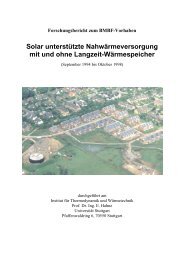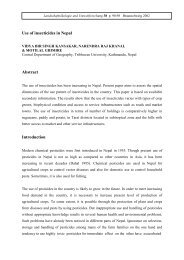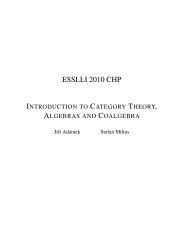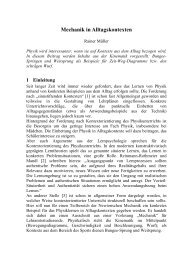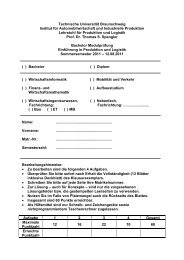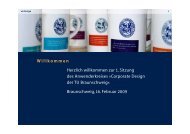Electrocatalytic and corrosion behaviour of tungsten carbide in near ...
Electrocatalytic and corrosion behaviour of tungsten carbide in near ...
Electrocatalytic and corrosion behaviour of tungsten carbide in near ...
You also want an ePaper? Increase the reach of your titles
YUMPU automatically turns print PDFs into web optimized ePapers that Google loves.
64<br />
F. Harnisch et al. / Applied Catalysis B: Environmental 87 (2009) 63–69<br />
For a better underst<strong>and</strong><strong>in</strong>g <strong>of</strong> the experimental results <strong>of</strong> this<br />
study, <strong>and</strong> <strong>of</strong> the complex properties <strong>of</strong> <strong>tungsten</strong> <strong>carbide</strong> <strong>in</strong><br />
general, a literature section precedes the paper, summariz<strong>in</strong>g the<br />
present knowledge <strong>of</strong> the material with respect to the subjects <strong>of</strong><br />
discussion.<br />
2. Literature survey<br />
2.1. Basic chemical properties <strong>and</strong> redox <strong>behaviour</strong> <strong>of</strong> <strong>tungsten</strong><br />
<strong>carbide</strong><br />
Tungsten <strong>carbide</strong> belongs to a group <strong>of</strong> materials known as<br />
<strong>in</strong>terstitial alloys <strong>of</strong> group IV B–VI B transition metals, <strong>in</strong> which<br />
elements like carbon (or nitrogen, silicon or phosphor) atoms<br />
occupy the <strong>in</strong>terstitial lattice positions <strong>of</strong> the metal [10,11]. These<br />
materials possess properties known from the group VIII metals,<br />
like <strong>of</strong> the precious metals plat<strong>in</strong>um or palladium [12]. Thus, they<br />
show remarkable catalytic activities, which have been attributed<br />
to a dist<strong>in</strong>ct electronic structure <strong>in</strong>duced by the presence <strong>of</strong> carbon,<br />
nitrogen or <strong>of</strong> phosphorous <strong>in</strong> the metal lattice [13]. In the case <strong>of</strong><br />
<strong>tungsten</strong> <strong>carbide</strong>, its catalytic activity has been expla<strong>in</strong>ed by the<br />
fill<strong>in</strong>g <strong>of</strong> the d-states at the Fermi level <strong>of</strong> <strong>tungsten</strong> by the alloy<strong>in</strong>g<br />
carbon [14,15].<br />
Yet, although <strong>tungsten</strong> <strong>carbide</strong> has by some authors been<br />
discussed to be isoelectronic to plat<strong>in</strong>um [12] it does not share its<br />
<strong>in</strong>ertness. When exposed to air, surface oxidation takes place <strong>and</strong><br />
advances with time [16]. Generally one can assume that <strong>tungsten</strong><br />
<strong>carbide</strong> is, if not stored under <strong>in</strong>ert gas atmosphere, always<br />
coveredbyoxidicspecies[17]. When exposed to water, <strong>tungsten</strong><br />
<strong>carbide</strong> undergoes cont<strong>in</strong>uous oxidation <strong>and</strong> dissolution. This<br />
process is pH dependent <strong>and</strong> follows zero-order k<strong>in</strong>etics [17]. In<br />
an earlier work, Voorhies [18] already po<strong>in</strong>ted out that the<br />
st<strong>and</strong>ard Gibbs free energy DG 0 <strong>of</strong> the WC oxidation is<br />
1336 kJ mol 1 , which leads to the conclusion that oxidants<br />
with a formal potential more positive than +100 mV (vs. SHE) will<br />
oxidise the surface <strong>of</strong> WC particles. This was also shown by Human<br />
<strong>and</strong> Exner [19] who estimated the <strong>corrosion</strong> potential <strong>of</strong> WC <strong>in</strong> N 2<br />
purged 0.1N H 2 SO 4 to be 105 mV (vs. Ag/AgCl). When the<br />
<strong>tungsten</strong> <strong>carbide</strong> particle is covered by an <strong>in</strong>sulat<strong>in</strong>g layer <strong>of</strong> WO 3<br />
no further oxidation will take place until a higher oxidation<br />
potential (>1 Vvs.SHE)isapplied,thatleadstothecomplete<br />
oxidation <strong>of</strong> the particle [20]. This result was also confirmed for<br />
the chemical oxidation <strong>of</strong> WC. Thus, it has been demonstrated that<br />
mild oxidants like ferricyanide (E 0 = 0.69 V vs. SHE) lead to an<br />
oxide monolayer formation, whereas stronger oxidants like Ce 4+<br />
(E 0 = 1.46 V vs. SHE) lead to bulk oxidation [18].<br />
At ultra high vacuum deposited <strong>tungsten</strong> <strong>carbide</strong> the film’s<br />
exact composition has been shown to critically <strong>in</strong>fluence its<br />
stability: whereas W 2 C was readily oxidized <strong>in</strong> 0.5 M H 2 SO 4 at<br />
500 mV (vs. NHE), WC was stable up to the oxygen evolution<br />
potential [21,22].<br />
The surface oxidation <strong>of</strong> <strong>tungsten</strong> <strong>carbide</strong> preferentially<br />
progresses on sites, where oxidic species already exist [23]. It<br />
leads to a simultaneous oxidation <strong>of</strong> <strong>tungsten</strong> <strong>and</strong> carbon.<br />
Carbon is oxidized to CO 2 , e.g., visible as a gas formation when<br />
<strong>tungsten</strong> <strong>carbide</strong> electrodes are oxidatively polarized (see, e.g.<br />
[7]). The exact nature <strong>of</strong> the formed <strong>tungsten</strong> oxides is difficult<br />
to characterize <strong>and</strong> is strongly depend<strong>in</strong>g on the applied<br />
potential, electrolyte composition, particle geometry <strong>and</strong><br />
particle pre-treatment. This relatively undef<strong>in</strong>ed composition<br />
<strong>of</strong> the surface oxide layers may be the major reason for the<br />
vary<strong>in</strong>g rest potentials <strong>of</strong> <strong>tungsten</strong> <strong>carbide</strong> electrodes, immersed<br />
<strong>in</strong> similar electrolyte solutions [23]. They also expla<strong>in</strong> the<br />
irreproducible hydrogen adsorption potentials at <strong>tungsten</strong><br />
<strong>carbide</strong> [23,24].<br />
2.2. <strong>Electrocatalytic</strong> hydrogen oxidation at WC<br />
The catalytic activity <strong>of</strong> <strong>tungsten</strong> <strong>carbide</strong> depends on many<br />
parameters. A major factor is the atomic ratio <strong>of</strong> <strong>tungsten</strong> <strong>and</strong><br />
carbon [8] <strong>in</strong> the <strong>in</strong>terstitial alloy. Thus, it is commonly acknowledged<br />
that high catalytic activity requires a carbon deficiency <strong>in</strong><br />
the material [25,16]. Other factors like the particle size, e.g., [26],<br />
lattice defects [26] <strong>and</strong> pseudometallic surfaces [9] have been<br />
(<strong>of</strong>ten controversially) discussed. Yet, one <strong>of</strong> the major factors that<br />
have been discussed to be determ<strong>in</strong><strong>in</strong>g for the electrocatalytic<br />
<strong>behaviour</strong> is the presence <strong>of</strong> oxidic species at the WC surface.<br />
Already <strong>in</strong> 1970 Böhm demonstrated that on freshly prepared WC<br />
electrodes with low oxide surface coverage no appreciable<br />
hydrogen adsorption takes place [27]. Only after anodic polarization<br />
the hydrogen adsorption properties could be improved, which<br />
was expla<strong>in</strong>ed by the facilitated hydrogen adsorption at the<br />
formed surface oxide species. This activation <strong>of</strong> the hydrogen<br />
adsorption (<strong>and</strong> consequently <strong>of</strong> the rate <strong>of</strong> hydrogen oxidation) by<br />
anodic polarization has been discussed by various authors. It has<br />
been shown that the electrochemical or chemical activation<br />
(oxidation) <strong>in</strong> electrolyte solutions leads to similar surface oxide<br />
layers as an extended exposure to humid air [16].<br />
The effect <strong>of</strong> activation can be reversed by an exposure <strong>of</strong> the<br />
WC sample to high temperatures <strong>in</strong> an <strong>in</strong>ert gas atmosphere [7] or<br />
<strong>in</strong> hydrogen [9], a procedure that reduces the surface species <strong>and</strong><br />
removes oxygen from the WC particle surface. The activation leads<br />
to the oxidation <strong>of</strong> <strong>tungsten</strong> up to W(VI), i.e., WO 3 . The thickness <strong>of</strong><br />
the <strong>tungsten</strong> oxide surface layer, formed by anodic polarization,<br />
was found to be between two <strong>and</strong> three monolayers, with the<br />
predom<strong>in</strong>ant species be<strong>in</strong>g hydrated <strong>and</strong> non-hydrated WO 3<br />
[7,9,23]. This oxide is known to be readily soluble <strong>in</strong> alkal<strong>in</strong>e<br />
solutions as WO 2<br />
4 . Therefore the anodic activation will here lead<br />
to a cont<strong>in</strong>uous dissolution <strong>of</strong> WC. At low pH, WO 3 is considered to<br />
be poorly soluble. Yet, due to its <strong>in</strong>sulat<strong>in</strong>g properties it can <strong>in</strong>hibit<br />
any electrocatalytic activity. To prevent the <strong>in</strong>hibition, the addition<br />
<strong>of</strong> H 2 or hydraz<strong>in</strong>e dur<strong>in</strong>g the anodic activation has been proposed,<br />
e.g., [28]. The addition <strong>of</strong> the reduc<strong>in</strong>g agents leads to a partial<br />
reduction <strong>of</strong> WO 3 <strong>and</strong> the subsequent dissolution <strong>of</strong> the more<br />
water soluble WO 3 x species [29]. It is obvious that such procedure<br />
leads to an <strong>in</strong>evitable dissolution <strong>of</strong> the WC catalyst. Furthermore,<br />
the stability <strong>of</strong> WO 3 <strong>in</strong> acidic electrolyte solutions is rather<br />
questionable. The given pro<strong>of</strong>s for the <strong>in</strong>solubility <strong>of</strong> WO 3 <strong>in</strong> acidic<br />
solutions orig<strong>in</strong>ate from older literature, e.g., [28], <strong>and</strong> they are<br />
likely based on <strong>in</strong>sufficient detection limits at that time. Newer<br />
publication clearly show that WO 3 layers on WC are not perfectly<br />
stable <strong>in</strong> 0.1 M H 2 SO 4 when polarized to 0.7 V (vs. SCE) [22,30].<br />
It has been demonstrated by different authors, that the<br />
activated electrodes lose their activity over time, however,<br />
levell<strong>in</strong>g at an activity higher than that prior to the activation<br />
[31]. The authors conclude that at that stationary level, which is<br />
characterized only by a m<strong>in</strong>imum activity loss, a cont<strong>in</strong>uous<br />
oxidation <strong>and</strong> dissolution <strong>of</strong> WC takes place. The rate <strong>of</strong> the<br />
dissolution process depends on several factors (apart from the<br />
electrolyte pH). Thus, the addition <strong>of</strong> cobalt ions has been shown to<br />
slow down the dissolution [20,32]. On the other h<strong>and</strong>, the presence<br />
<strong>of</strong> phosphate ions can greatly enhance the rate <strong>of</strong> dissolution—<br />
through the formation <strong>of</strong> soluble heteropolytungstates [6,33].<br />
Tak<strong>in</strong>g <strong>in</strong>to account that the activation procedure <strong>in</strong>volves the<br />
formation <strong>of</strong> surface oxides, it is very likely that these oxides play<br />
the major role for the catalytic activity <strong>of</strong> <strong>tungsten</strong> <strong>carbide</strong>. Yet, this<br />
role has been discussed rather controversially. Whereas some<br />
authors speculated, that <strong>tungsten</strong> oxides are the catalytic centres,<br />
their ability to act as catalytic centres was denied <strong>in</strong> other studies<br />
[26]. But due to their complex nature <strong>and</strong> the <strong>in</strong>dividually<br />
proceed<strong>in</strong>g oxidation process at the <strong>in</strong>dividual WC particle it is






